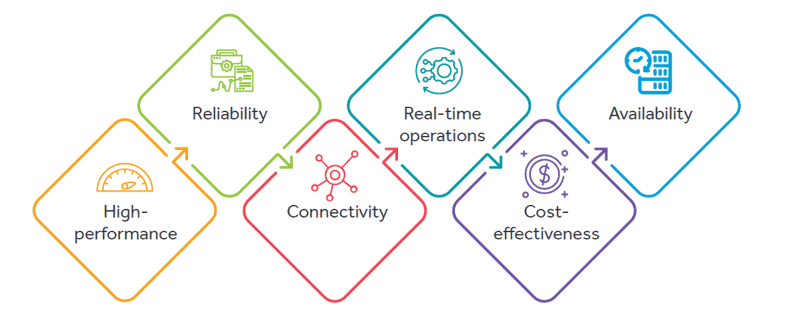Exploring the Future of Dynamic Edge Computing with GEESE and UAV Collaboration
Written by Sushma TN 12 Mar, 2025
In previous blog posts, we’ve explored the transformative role of Unmanned Aerial Vehicles (UAVs) in the Architecture, Engineering, and Construction (AEC) industry and advancements in UAV-Enabled Edge Computing (UEC). UAVs are revolutionizing the AEC with precise mapping, real-time tracking, and improved safety and communication on construction sites. They also extend their applications to infrastructure monitoring, energy inspections, and disaster response, making them essential tools for modern project management and emergency operations.
Edge Computing with UAVs: Overcoming Limitations
The integration of edge computing with UAVs addresses the challenges like limited computational resources and battery life. By processing data locally, edge computing reduces latency and improves real-time data analysis. This increases UAV efficiency for smart city planning, infrastructure maintenance, and disaster recovery. With technologies like Cyient’s IoT and edge solutions further optimize UAV performance, industries can make quicker, data-driven decisions and improve operational intelligence.
Looking ahead, the convergence of UAVs and edge computing will drive innovation and efficiency across multiple sectors, enhancing operational capabilities, safety, and sustainability in an increasingly digital world.
Traditional Edge Computing and Its Limitations
Traditional edge computing faces scalability and adaptability challenges due to static edge servers in fixed locations. When large crowds or unexpected events occur, these systems can become overwhelmed, resulting in performance issues. Additionally, edge computing infrastructure often struggles to meet the dynamic needs of users, especially in remote or evolving environments.
Energy consumption is another significant concern. Processing large sensor data streams quickly drains mobile device batteries, limiting performance unless offloaded to powerful servers . Furthermore, traditional centralized data analytics systems often struggle with real-time processing, as they rely on sending massive amounts of IoT data to centralized cloud infrastructure, causing latency.
Critical applications like surgical robots, airplanes, and cars, rely on uninterrupted connectivity. If cloud processing is interrupted, systems can become unreliable. The growing number of connected devices also increases the bandwidth demand, potentially overwhelming cloud systems. Edge analytics addresses these challenges by processing data locally, reducing latency, enhancing reliability, and minimizing the need for large-scale cloud data transfers.

Introducing GEESE: Dynamic Edge Computing with UAVs
GEESE (Global Edge-Enhanced Sensing and Execution) is an innovative system designed to integrate UAVs with “cloudlets”—portable computing resources that UAVs can transport for on-site computation. By using UAVs to deliver cloudlets to remote or challenging locations, such as disaster zones or underwater environments, GEESE revolutionizes edge computing by enabling real-time data processing at the network’s edge.
The system evaluates how different types of UAVs— whether aerial, ground, or underwater—can carry cloudlets of varying sizes and weights. By coordinating multiple UAVs, GEESE creates a scalable and flexible edge computing infrastructure that overcomes the scalability and adaptability limits of fixed-edge servers, ensuring resources are deployed as needed during surges in demand.
Cooperative UAVs for Scalable Edge Computing
The power of GEESE lies in the collaboration of UAVs. For example, when large crowds gather, UAVs can quickly deploy cloudlets to handle the surge in data analysis demand. This cooperative system allows for scalable, real-time edge computing, adapting resources as user movement or environmental conditions change.
GEESE’s innovative resource delivery model calculates the required number of UAVs and cloudlets needed to ensure that users receive the right level of computing power without wasting resources. Furthermore, GEESE enables UAVs to dynamically adjust computing resources in response to user movement or changing conditions, ensuring consistent service delivery.
Key Insights from GEESE's Design and Performance
GEESE enhances edge computing by using portable cloudlets transported by UAVs, enabling dynamic deployment of resources where needed. The collaboration of aerial, ground, and underwater UAVs ensures reliable computing even in evolving environments. GEESE also introduces scalable models that adjusts resources to meet varying demands, ensuring consistent performance during large events or emergencies. Its optimized resource delivery model ensures efficient allocation of UAVs and cloudlets based on user mobility and data processing needs.
The Path from Model Creation to Edge Deployment:
The journey from Model Creation to Edge Deployment is a critical process for enabling real-time decision-making through edge analytics in the rapidly advancing IoT and AI landscape. By processing data closer to the source, edge analytics minimizes latency and reduces reliance on cloud infrastructure, making it ideal for industries like automotive and healthcare.
Through Model Training, the AI model is fine-tuned and optimized for the target hardware, ensuring maximum efficiency. Following this, Model Deployment ensures the model can perform inferencing on edge devices, supported by necessary libraries and hardware accelerations like GPUs. To keep the system performing at its best, regular updates for models, firmware, and applications ensure continuous improvement and adaptation to new data and requirements.
Applications and Future Potential
The GEESE system and UAV-based edge computing unlock transformative possibilities across industries. By dynamically deploying cloudlets, UAVs can provide real-time, large-scale data processing for critical applications such as disaster response, smart city optimization, environmental monitoring, and industrial IoT. These advancements reduce latency and offer scalable solutions for diverse and challenging environments.
GEESE marks a major breakthrough in edge computing, enabling the dynamic deployment of computing resources through UAVs. This innovation addresses the limitations of traditional cloud and edge computing solutions, providing scalable and real-time data processing capabilities in challenging environments. As UAV technology progresses, the potential for UAV-based edge computing to revolutionize industries, enhance user experiences, and create new applications is immense. The future of dynamic, distributed computing lies in the synergy between UAVs and cloudlets, with GEESE at the forefront of this groundbreaking development.
Cyient’s Edge Computing for UAVs
Cyient is advancing UAV operations with IoT and edge computing solutions. Its Onboard Sensor Modules enable precise surveying, monitoring, and inspections, while the IoT Edge Gateway 5400 ensures real-time analytics with Azure connectivity and robust communication options. By reducing latency, optimizing bandwidth, and enhancing security, Cyient’s solutions power smarter, more efficient UAV applications. Read more... (Link Blog #2)
About the Author

Sushma TN
Senior Subject Matter Expert, Spatial Intelligence
Sushma is a seasoned GIS analyst with 17 years of expertise in GIS, remote sensing, and AI/ML training data applications. Her extensive experience spans navigation maps, network design, process planning, and data analysis. She has contributed to several renowned organizations in the GIS industry, delivering impactful solutions to Fortune 500 clients and showcasing a diverse skill set across complex projects.
.png?width=774&height=812&name=Master%20final%201%20(1).png)